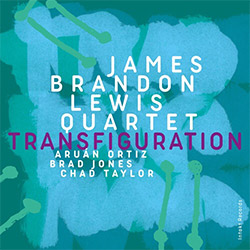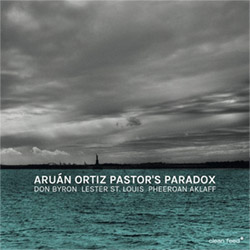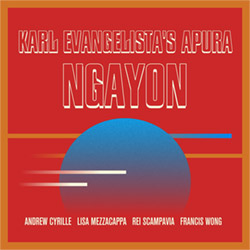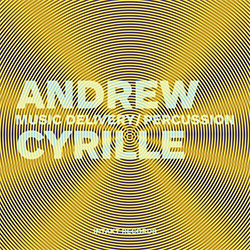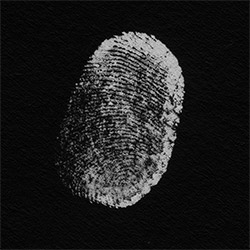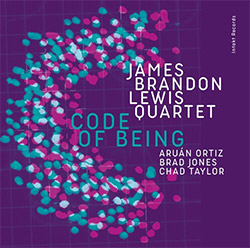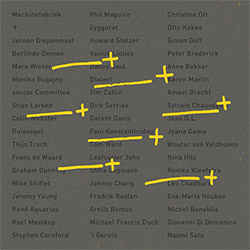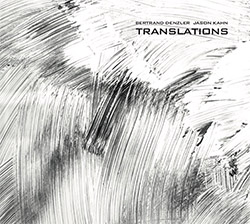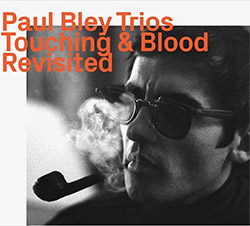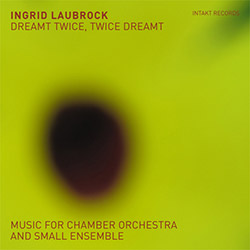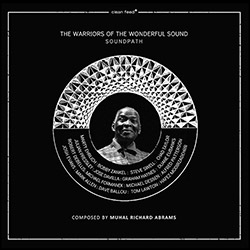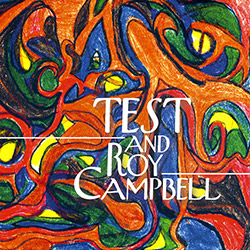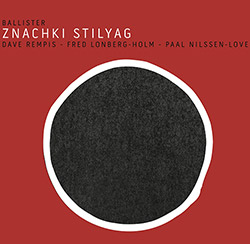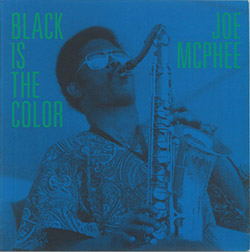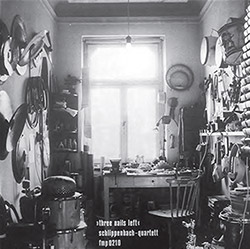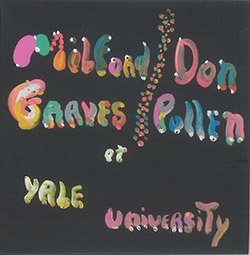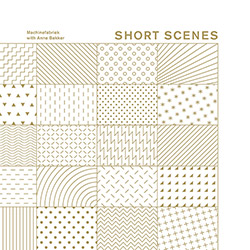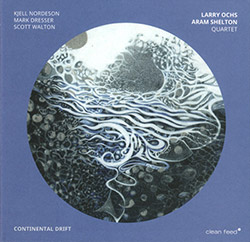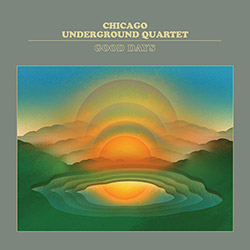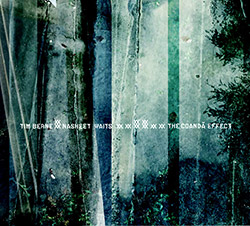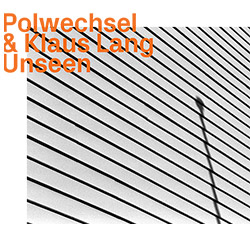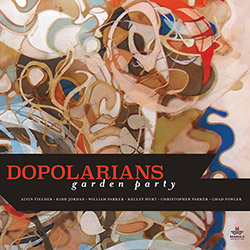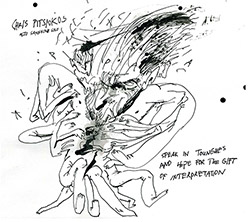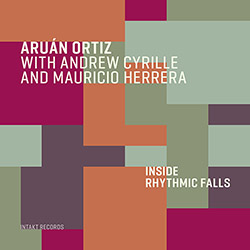
Cuban pianist Aruán Ortiz reflects on his upbringing in Santiago de Cuba, evoking the cascades of daily sound and rhythm he heard there, through compositions performed with the trio of fellow Cuban Mauricio Herrera on percussion & marimbula, and drummer Andrew Cyrille, Emeline Michel and Marlene Ramirez-Cancio providing vocals on the powerful opening invocation.
Out of Stock
Quantity in Basket: None
Log In to use our Wish List
Shipping Weight: 4.00 units
Sample The Album:
Andrew Cyrille-drums
Mauricio Herrera-marimbula, bongos, percussion, cowbell
Aruan Ortiz-piano, voice
Emeline Michel-vocals
Marlene Ramirez-Cancio-vocals
Click an artist name above to see in-stock items for that artist.
UPC: 7640120193393
Label: Intakt
Catalog ID: ITK339.2
Squidco Product Code: 28682
Format: CD
Condition: New
Released: 2020
Country: Austria
Packaging: Jewel Case
Recorded at Sear Sound Studio, in New York City, New York, on May 24th and 25th, 2019, by Chris Allen.
"Aruan Ortiz has long dreamt of making an album that would evoke "a cascade of rhythms going over me, almost dragging me to fall." This feeling of being overtaken by rhythm is one he knows well, having spent his first 23 years in Cuba. Born in 1973, Ortiz grew up Santiago de Cuba - the cradle of Afro-Cuban music and a veritable "vortex of rhythm". Ortiz captures the symphony of everyday life in Oriente on his arresting new album, Inside Rhythmic Falls. "I think of myself as a storyteller," Ortiz says, "and each of the album's ten tracks tells a story about Oriente province." For this project Ortiz has chosen Cuban percussionist Mauricio Herrera and one of the best drummers of today's jazz to his side. Andrew Cyrille was born in Brooklyn, New York into a Haitian family. "Rhythm is life ... the space of time danced through," and inside rhythmic falls everyone is possessed by the dance, both leading and following. The New York jazz critic Adam Schatz writes in the Liner notes: "When music is this glorious, it has the power not just to conjure spirits but to inspire belief and help us experience the marvelous. Or, as Carpentier also put it, the marvelous real."-Intakt
"The thing that's most attractive about Cuban-born Aruán Ortiz is not that his jazz is informed by the culturally-rich music of his homeland; it's that he uses his background as a springboard for pushing jazz to its limits. His compositions and piano reach toward freedom, ending up in a place that is an abstraction of what inspires them, while also writing a new chapter to the book of Afro-Cuban jazz.
Inside Rhythmic Falls is a direct acknowledgement that the music originating from the Cuban Oriente province of his birthplace is driven heavily by its rhythms. That's why for this project, Ortiz is supported only by rhythmists: percussionist Mauricio Herrera and the great icon of progressive drums, Andrew Cyrille. This certainly isn't a trio in the normal sense of the word, and often, it isn't even a trio performing; all combinations of the three are used throughout the album. And Ortiz means business when he stated his intention of this album to be about the rhythm, as the opener "Lucero Mundo" is Cyrille and Herrera only.
"Conversation With The Oaks" is where Ortiz's piano is actually introduced and after a fitful start, Ortiz blurts out chords in a random fashion but Cyrille confidently finds the right pulse for it. After a while it becomes clear that the pianist's free playing has a rhythmic purpose to it that's even stronger than the harmonic one.
The full trio finally comes together, for "Marimbula's Mood." Herrera plays a marimbula, which is akin to bigger version of an African kalimba, and it's lower resonance almost occupies the bass area of the performance, though the notes don't necessarily correspond to Ortiz's piano. Instead, it serves as an anchor to the roaming around done by Ortiz and Cyrille.
"Golden Voice (Changüi)" is a flirtatious give-and-take between Ortiz and Cyrille, who taps on his toms with the dexterity of a highly-skilled pianist (like, say, Ortiz). Ortiz continues his mastery of the space between the notes with "De Cantos y Ñáñigos," those spaces being filled up amply by Cyrille's brushes. Cyrille and Herrera combine for a trance-like barrage of percussion for "Inside rhythmic falls. Part I (Sacred Codes)."
"Argelier's Disciple" is Ortiz leaving behind impressionist blotches that Cyrille and Herrera dance around. He ruminates over a small cluster of notes for "Inside rhythmic falls. Part II (Echoes)" that evolves into insistent, rhythmic patterns around which Cyrille exploits.
The album concludes with a pair of brief sketches, the parched piano/percussion interlude "El Ashé de la palabra" and another Ortiz/Herrera collaboration, "Para ti nengón," where they sing this traditional Cuban song over the impulsive improv they are playing. That two-minute moment seems to encapsulate the message of Inside Rhythmic Falls, using the time-worn beats and sounds of Cuba to inform something that seems of another world and another century.
Aruán Ortiz's bold new conception for Afro-Cuban jazz continues by delving deeper into the rhythmic patterns and turning them inside-out much as he has previously done with the harmonics of the music."- S. Victor Aaron, Something Else
Get additional information at Something Else!
Artist Biographies
• Show Bio for Andrew Cyrille "Andrew Charles Cyrille (born November 10, 1939) is an American avant-garde jazz drummer. Throughout his career, he has performed both as a leader and a sideman in the bands of Walt Dickerson and Cecil Taylor, among others. Cyrille was born on November 10, 1939, in Brooklyn, New York into a Haitian family. He began studying science at St. John's University, but was already playing jazz in the evenings and switched his studies to the Juilliard School. His first drum teachers were fellow Brooklyn-based drummers Willie Jones and Lenny McBrowne; through them, Cyrille met Max Roach. Nonetheless, Cyrille became a disciple of Philly Joe Jones, who in some performances such as Time Waits used Cyrille's drum kit. His first professional engagement was as an accompanist of singer Nellie Lutcher, and he had an early recording session with Coleman Hawkins. Trumpeter Ted Curson introduced him to pianist Cecil Taylor when Cyrille was 18. He joined the Cecil Taylor unit in 1964, and stayed for about 10 years, eventually performing drum duos with Milford Graves. In addition to recording as a bandleader, he has recorded and/or performed with musicians such as David Murray, Irène Schweizer, Marilyn Crispell, Carla Bley, Butch Morris and Reggie Workman among others. Cyrille is currently a member of the group, Trio 3, with Oliver Lake and Reggie Workman." ^ Hide Bio for Andrew Cyrille • Show Bio for Mauricio Herrera "Mauricio Herrera is from the eastern province of Holguin, Cuba. The interest in music comes from the musical legacy of his family but He first entered the world of music was at age 7 playing violin, but by 14 began studying percussion where he found his niche. After graduation from the Jose Maria Ochoa Conservatory in Holguin, he began playing in various local popular and folkloric groups and was on faculty at Escuela Vocacional de Arte. In 1994 he moved to La Habana to broaden his horizons, where he played, toured, and recorded with several of the most prominent Popular bands in the Nineties in Cuba as Paulito FG y su Elite, Manolito Simonet y su trabuco, Manolín el Medico de la salsa, Pachito Alonso y sus Kini Kini. Juan Kemmel y la Barriada, Hector Valentin, Angel Bonne., In 2001 he relocated to Mexico where he played with several projects including Otra Idea Orquestra, Amaury Gutierrez, David Torrens, and many others. In 2005 Mauricio moved to New York where he currently resides. He has played, recorded and toured with: David Sanchez, Stefon Harris, Nicholas Payton, Christian Scott - 90 Miles Project, Gonzalo Rubalcaba, Ignacio Berroa, Yerba Buena, Lila Downs, Manuel Valera and the New Cuban Express, Alfredo de la Fe, Bryan Lynch, Luis Perdomo, The Rodriguez Brothers, Dave Samuels and The Caribbean Jazz Project, Hector Martignon, Batyr Shukenov, La India, Spanish Harlem Orquestra, Steve Coleman, Jackie Terrasson, John Benitez, Mark Weinstein, Lew Soloff, Aruan Ortiz, Candido Camero, Yerba Buena, Osmany Paredes , Pedro Martinez y Grupo Ibboru, Cimarron project, Francisco Mela, Robby Ameen featuring Ruben Blades, Yosvany Terry Afrocuban Roots & Sextet and many others. Mauricio Herrera Has Given Concerts and Master Classes in Different Music Colleges and Universities as, Boys & Girls Harbor ,The Banff Centre in Canada, Berklee College of music, Yale University, Harvard University, Stanford University, JAZZUV University in Xalapa Mexico. and also performing around the World with Several major artists from the Scene of Jazz and other Musical Genres. Mauricio is Currently Endorsed by Latin Percussion LP and Vic Firth Drum Sticks." ^ Hide Bio for Mauricio Herrera • Show Bio for Aruan Ortiz "Cuban-born, Brooklyn-based pianist, violist, and composer Aruán Ortiz has written music for jazz ensembles, orchestras, dance companies, chamber groups, and feature films. His work incorporates influences from contemporary classical music, Cuban-Haitian rhythms, and avant-garde improvisation; and consistently strives to break stylistic musical boundaries. He has been called "the latest Cuban wunderkind to arrive in the United States" by BET Jazz and "one of the most versatile and exciting pianists of his generation" by Downbeat Magazine. He has received numerous accolades such as the Doris Duke Impact Award (2014); Composers Now Creative Residency Award at Pocantico Center of the Rockefeller Brothers Fund (2014); the Jerome Foundation Travel & Study Grant (2013); Latin Jazz Corner's Arranger of the Year (2011) for his contribution on the album, "El Cumbanchero" by flutist Mark Weinstein (Jazzheads, 2011); Fundación Autor, SGAE, and Generalitat de Catalunya Grant study grants (2002); Semifinalist, Jas Hennessy Piano Solo Competition, Montreux, Switzerland (2001); and Best Jazz Interpretation, Festival de Jazz in Vic, Spain (2000)." ^ Hide Bio for Aruan Ortiz • Show Bio for Emeline Michel "Haitian songstress and Red Cross Ambassador Emeline Michel is internationally acclaimed for fusing pop, jazz, blues, and traditional Haitian rhythms into deeply moving, joyful music delivered with a charismatic live show. A master entertainer, Michel has shared her message with audiences for more than 20 years, including appearances at Carnegie Hall, The United Nations, Milan's Teatro Manzoni, Florida's Kravis Center, Festival International de Jazz (Haiti), Ontario's Luminato Festival, Montreal International Jazz Festival, New Orleans Jazz Fest, Tasmania's Ten Days On The Island, Zimbabwe's Harare International Arts Festival, and MTV's Hope for Haiti Now: A Global Benefit for Earthquake Relief. Hailed by the New York Times as a "diplomat of music" and "the dancing ambassador with a voice serene and warm like the breeze," Michel began singing with the gospel choir in the church of Gonaïves, Haiti. After studying at the Detroit Jazz Center she returned to Haiti, where her career blossomed. Now based in New York City, she runs her own production company, Production Cheval de Feu, and is a cherished voice for social issues surrounding women and children worldwide. Her most recent album Quintessence captures the reverence and gratitude for the present moment, showcasing Michel's virtuoso vocal, singing in Creole, French and English, with finger-picked guitars, soulful backing vocals, a children's choir, Haitian percussion, lush strings, playful trumpet and accordion lines." ^ Hide Bio for Emeline Michel • Show Bio for Marlene Ramirez-Cancio "Marlène Ramírez-Cancio is Associate Director, Arts & Media, at the Hemispheric Institute of Performance and Politics. Housed at NYU, Hemi connects artists, scholars, and activists, forging spaces of creative inquiry and critical practice that enliven struggles for justice in the Americas. In her role, she heads up the curation and production of Hemi's large-scale, biannual Encuentros, which gather about 700 participants in different cities throughout the Americas; curates HIDVL, a growing digital video library that archives and circulates the work of politically engaged artists; directs EMERGENYC, Hemi's emerging artist program focused on art and activism; initiated and runs Hemi's Artist Residencies for local NYC artists; and has co-created initiatives like the Helix Queer Performance Network, supporting queer artists of color and fostering intergenerational mentorship. Marlène is also co-founder and co-director of Fulana, a Latina satire collective collective whose videos have been shown internationally at film festivals, museums, and universities, and whose members lead satire and parody workshops for emerging artists. She serves on the Board of Directors of the National Performance Network and the Center for Artistic Activism's Advisory Board. In 2018, she curated "Cuerpxs Radicales: Radical Bodies in Performance," a live art series presented at the Brooklyn Museum in conjunction with the Radical Women: Latin American Art, 1960-1985 exhibition." ^ Hide Bio for Marlene Ramirez-Cancio
4/10/2024
Have a better biography or biography source? Please Contact Us so that we can update this biography.
4/10/2024
Have a better biography or biography source? Please Contact Us so that we can update this biography.
4/10/2024
Have a better biography or biography source? Please Contact Us so that we can update this biography.
4/10/2024
Have a better biography or biography source? Please Contact Us so that we can update this biography.
4/10/2024
Have a better biography or biography source? Please Contact Us so that we can update this biography.
Track Listing:
1. Lucero Mundo 3:14
2. Conversation with the Oaks 6:12
3. Marimbula's Mood 5:11
4. Golden Voice (Changui) 7:55
5. De Cantos y Nanigos 6:40
6. Inside Rhythmic Falls. Part I (Sacred Codes) 2:43
7. Argelier's Disciple 7:09
8. Inside Rhythmic Falls. Part II (Echoes) 6:27
9. El Ashe de la Palabra 1:56
10. Para ti Nengon 2:02
Improvised Music
Jazz
Free Improvisation
NY Downtown & Metropolitan Jazz/Improv
Trio Recordings
Song Based Music
Spoken Word
Melodic and Lyrical Jazz
Staff Picks & Recommended Items
Intakt
Last Copy of Items that will not be restocked...
Search for other titles on the label:
Intakt.



